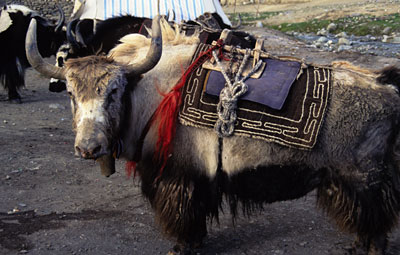WILD YAK
Bos grunniens (drong in Tibetan)
The yak symbolises Tibet—and symbolises the romance of the high plateau. Indeed, Tibetan nomads cannot survive without the domesticated yak. It is thought that wild yaks were domesticated by Tibetans many centuries ago. The wild ones are still around, but highly endangered. It is not known how many survive in the wild in Tibet.
The wild yak is an enormous creature: an adult male can weigh up to 900 kilograms (equivalent to double the weight of a domestic yak), and can stand almost two metres high at the shoulder. Wild yaks mostly graze on grass and herbs. They are sure-footed over rough terrain: herds travel on snow in single file, carefully stepping on footprints left by the lead yak. The wild yak's long shaggy coat enables it to withstand violent winds and snowstorms.
DOMESTIC YAKS AND NOMAD SURVIVAL
Yaks are superbly adapted to high-altitude living and cold conditions—in fact, so well-adapted that they cannot survive if shifted to lower elevations. And Tibetan nomads cannot survive without domestic yaks. They depend on them for everything. Nomads live in one of the harshest environments in Asia—a high, treeless, windswept plateau—one covered with alternate large expanses of desert and grassland regions. Yaks rely on the grasslands for pasture—and Tibetans are dependent on yaks for food, fuel and shelter.
Domestic yaks are found across the Tibetan Plateau—including Tibet central, Kham, Amdo, and in Nepal, Bhutan, parts of northern India, northern Pakistan and Mongolia. The yak may look like a comical creature—best described as a cow with a skirt—but is a serious matter for Tibetan nomads. Every part of the yak is used in one way or another. Yak milk, yoghurt, butter and cheese provide sustenance—derived from the female yak (dri in Tibetan). Yak-butter tea is steadily consumed by Tibetan nomads—up to 40 cups a day. This consists of black tea churned with yak-butter instead of milk—definitely an acquired taste. Yak meat is also consumed at times: it is preserved in dried or semi-dried form—a kind of yak jerky.
Nomads live in thick heavy tents woven from the hair of the yak. The hair and hide of the yak are used for making thread, blankets, ropes, bags, clothing and boots. Yak dung is collected and stacked—it is the main fuel source on the treeless plateau. Yaks are used as pack animals for transport when moving to new pastures. Yak-hide is even used to make ingenious small boats for river crossings.
